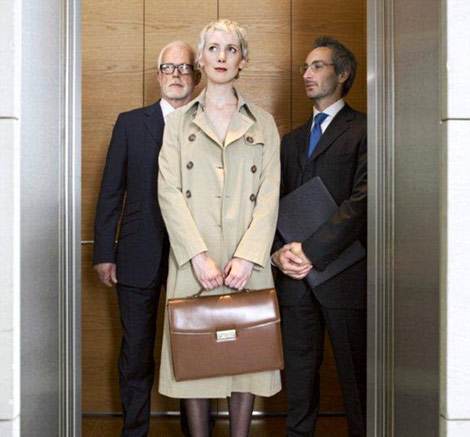|
 According to new research, there could be a social hierarchy attached to where people stand in the lift. More senior men stand at the back, young men in the middle and women of all ages at the front. |
|
Most people know that awkward feeling when you shuffle into an elevator with other people and try not to make eye contact. But new research suggests it may be down to a subconscious power struggle being played out as you make your way up or down. A study found that people decide where they stand based on a micro social hierarchy, established within seconds of entering the lift. Rebekah Rousi, a Ph.D. student in cognitive science, conducted an ethnographic study of elevator behaviour in two of the tallest office buildings in Adelaide, Australia. As part of her research, she took a total of 30 lift rides in the two buildings, and discovered there was an established order to where people tended stand. In a blog for Ethnography Matters, she writes that more senior men seemed to direct themselves towards the back of the elevator cabins. She said: 'In front of them were younger men, and in front of them were women of all ages.' She also noticed there was a difference in where people directed their gaze half way through the ride. 'Men watched the monitors, looked in the side mirrors (in one building) to see themselves, and in the door mirrors (of the other building) to also watch others. 'Women would watch the monitors and avoid eye contact with other users (unless in conversation) and the mirrors,' she writes. The doctorate student concluded it could be that people who are shyer stand toward the front, where they can't see other passengers, whereas bolder people stand in the back, where they have a view of everyone else. (Source: Dailymail)
|
当你拖着脚和其他人一道走进电梯时,会尽量避开别人的目光,这种尴尬的感觉大多数人都了解。 但是新研究指出,在你上下电梯时,你的表现可能源自一种下意识的权利斗争。 一项研究发现,人们在进电梯后数秒之内,就会根据一种微观社会等级来决定自己站的位置。 认知科学专业的博士生瑞贝卡•茹茜在澳大利亚阿德莱德市最高的两座办公大楼里开展了一项关于电梯行为的人类学研究。 作为研究的一部分,她在这两座大楼里一共搭乘了30次电梯,并发现人们倾向于按既定的秩序来选择自己在电梯里站的位置。 在“人种志事态”博客中,她写道,地位较高或年长的男人似乎更喜欢站在电梯轿厢的后面。 她写道:“站在老年男人前面的是年轻一些的男人,站在年轻男人前面的是各个年龄段的女人。” 她还注意到,人们在乘梯途中目光的方向也有差异。 她写道:“男人会看看电梯楼层显示器,看一下(其中一座大楼)侧面镜子中的自己,或看看(另一座大楼的)镜面门反射出的别人的影像。 “女人则会盯着电梯楼层显示器,避免和其他用户发生眼神接触(除非有人和自己谈话),或者看镜子。” 这名博士生得出结论说,那些比较害羞的人会站在电梯前面,这样他们就看不到其他乘客,而胆子较大的人会站在后面,这样他们就能看到每个人。 相关阅读 (中国日报网英语点津 陈丹妮) |
|
Vocabulary: shuffle: 拖着脚走 |
